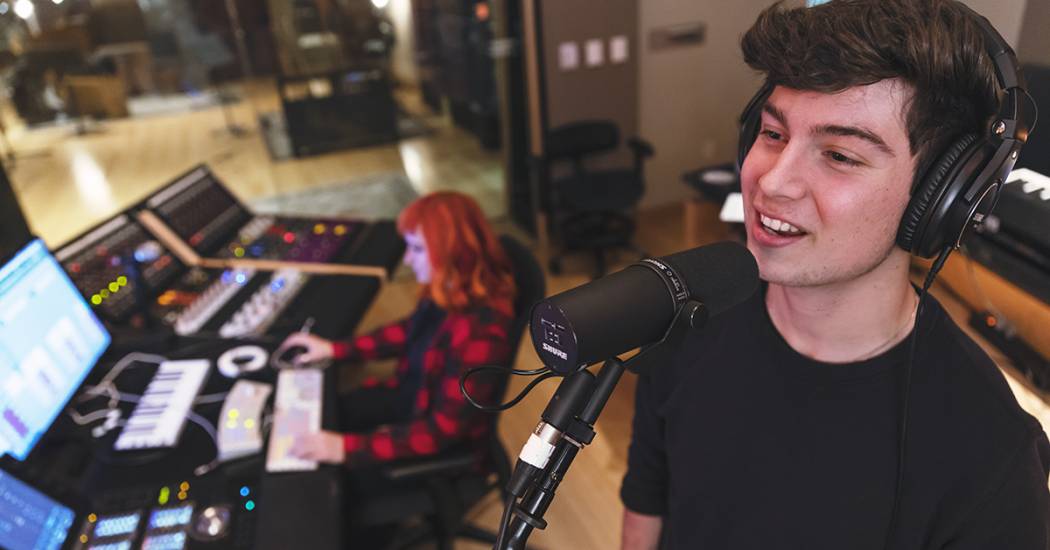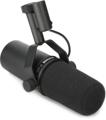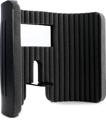
When tracking vocals, best practice dictates that the performer be recorded in a vocal booth or in a pro-designed live room. That said, performance trumps everything else — every time. And, if the vocalist feels uncomfortable in a typical recording scenario, you’ll need to alter your approach if you want to squeeze an award-winning take out of them. In this article, we’ll explore different methods of recording vocals in a control room (or in a one-room home studio).
Does Anyone Actually Do This?
Do artists really record vocals in the control room? And does it sound good? Well, Bono of the legendary band U2 is rumored to have captured many of his vocals with a Shure SM58–style handheld dynamic mic in the control room with the studio monitors blaring. His Purple Majesty, Prince, is reputed to have done the same thing with a Shure SM57. According to producer Michael Beinhorn, Chris Cornell became self-conscious during the recording of Soundgarden’s breakthrough album Superunknown, so everybody left the room, and Chris tracked the vocals by himself right in front of the console. Twenty One Pilots’ Tyler Joseph designed his one-room home studio to allow him to record his vocals using a handheld Shure SM7B. And Sweetwater’s Lynn Fuston recorded rapper Toby McKeehan of Christian supergroup DC Talk through a ’50s-era EV 630 handheld dynamic while Toby sat on the control-room couch.
Get Your Room Primed and Ready for Action
Before you can even think about tracking vocals in your control room, you need to ensure that it’s up to the job acoustically. If you’re working in a professionally designed space, then we’ll assume you’re good to go. But, if you’re recording in an untreated home studio, you’ve got a bit of work to do to bring your space up to snuff. A modest investment in bass traps and studio foam will go a long way toward transforming your subpar space into a proper recording environment, and it’s likely to improve your mixes, as well.
For more information on this topic, check out our Acoustic Treatment Buying Guide or place a call to your Sweetwater Sales Engineer.
Four Alternatives
Track your vocals wearing headphones
One common solution for recording in the control room is to use headphones. This scenario is the easiest to manage, and it’s the way most home recordists with one-room setups work (those with a single multipurpose tracking and control room).
For top-level results, you’ll want to use closed-back headphones to minimize leakage into your microphone. Sonic isolation is important, thus an sE Electronics Reflexion Filter PRO or a Primacoustic VoxGuard VU will elevate the quality of your vocal recordings, especially if you’re using a sensitive microphone such as a large-diaphragm condenser.
Many vocalists like to remove their headphones from one ear so they can hear themselves in a familiar way: within the context of the room’s natural acoustics. If this describes your situation, then make a mono cue mix and pan it to the earcup they’re using. This will keep sound from the unused earcup from bleeding into the microphone and will enable the vocalist to hear all the instruments in the mix.
Replicate the onstage experience with speakers
Some artists are very averse to wearing headphones. This is especially true of seasoned live musicians who are used to performing onstage with monitor wedges. In these situations, giving the vocalist a handheld microphone and planting them in front of cranked studio monitors will often put them at ease. I used this technique while working with the melodic hard-rock band Vagrant. I even pointed an aluminum-reflector heat lamp at the lead vocalist’s sunglasses-covered face to simulate stage lights!
The challenge of recording in front of speakers lies in minimizing the level of bleed from the monitor mix into the microphone. Too much spill makes it difficult to add compression and other processing to the vocal during mixing, and it can cause phase cancelations that will adversely affect your mix.
So, how can you cut down on monitor spill? For starters, use a cardioid microphone. You might think a supercardioid or a hypercardioid microphone would work also since these offer good off-axis rejection, but be aware that they have a lobe where they pick up sound directly behind the mic, which may be problematic because it will be picking up what you want to avoid. Moving-coil-type dynamic mics are a great choice as their sensitivity specs will cut down on extraneous room noise. Beyond that, a noise gate is an excellent way to eliminate unwanted sounds between words and phrases. Finally, encourage the vocalist to hold the mic (relatively) close to their mouth to increase the ratio of their voice to the monitor bleed.
Kill the spill with the “reversed polarity technique”
If you want a cleaner vocal track, then you can minimize monitor bleed by using what we’ll refer to as the “reversed polarity technique.” To apply this trick, fold the cue mix down to mono then reverse the polarity of one of the speakers. (For passive speakers, this is as easy as reversing the red and black leads on the rear of the speaker. For active speakers, you’ll need a cable or an adapter that reverses pins 2 and 3 going to the speaker, which inverts the polarity of the incoming signal.) This will create a “null” point at a position equidistant from both speakers (where the polarities of the two speakers cause the sound to cancel). Finally, place the vocal mic in the null point.
While this approach can be effective at reducing monitor spill, it does have its drawbacks. Its most notable downside is that the mix that the vocalist hears will have a hollow, out-of-phase character to it that gets even weirder if the vocalist moves their head around — a far cry from the natural sound they’re likely used to. This sound is so off-putting, in fact, that they may actually find that they prefer the headphone mix to the reversed-polarity version!
Impede the bleed with the “cue mix playback method”
A similar — and often preferred — technique is what we’ll call the “cue mix playback method.” To employ this approach, place the vocal mic in the exact spot where the vocalist will be. Next, set the playback level to the exact level it will be during vocal tracking. Then, play back the instrumental cue mix and record it through the vocal mic. Last, reverse the polarity of the recorded cue mix.
After you track the vocalist, the reverse-polarity instrumental track should cancel out any monitor bleed that was captured when recording the vocal. Sound complicated? No problem. iZotope RX 9 includes a De-bleed module that executes a similar technique for you automatically.
Pro Tip: High-frequency content proves the most difficult to null when using phase-canceling techniques. Placing a lowpass filter on the cue mix during playback is a great way to nip this issue in the bud before it becomes problematic.
Conquer Vocal-booth Anxiety for Good
If you’re tired of dealing with vocal-booth anxiety, then you can avoid the booth altogether by employing one of the approaches outlined above. Questions? Don’t hesitate to contact your Sweetwater Sales Engineer at (800) 222-4700. They’ll give you the expert advice you need to take your recordings to the next level.





